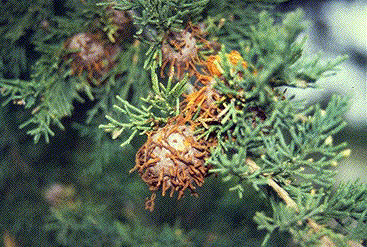Cedar-apple rust
Natural History

Mature cedar-apple rust galls on a redcedar tree
Photo credit: Department of Plant Pathology, University of Missouri-Columbia
Cedar-apple rust is caused by a fungus (Gymnosporangium juniperi-virginianae) but unlike many diseases, this fungus requires two different trees (hosts) to complete its life cycle - a redcedar tree and an apple or hawthorn tree. The pathogen produces tumor-like growths (galls) on branches of redcedar trees but causes little damage to these trees. The disease also causes damage to apple or hawthorn leaves and fruit. Cedar-apple rust is not uncommon in Florida but is not considered much of a threat. The disease causes great concern in states where apple orchards are big cash crops.
The life cycle starts in late summer when spores are produced on the leaves of hawthorn or apple trees. The spores are carried by wind to redcedar trees. The spores eventually develop into galls. The galls produce bright orange, jelly-like horns that create new spores. These new spores are carried by wind to apple and hawthorn trees where the cycle starts again.
Note: The common names used for both the disease and the trees can make this subject a little confusing. In spite of its name, cedar-apple rust doesn't actually infect the true cedars, which have needles like pines and are in the genus Cedrus. What is called a "redcedar" in the eastern U.S. is actually a type of juniper and has branches covered in tiny green scales. Cedar-apple rust only infects these redcedars and other related species in the genus Juniperus. It would be more accurate to change the name of the disease to "juniper-apple rust," but that isn't likely to happen anytime soon.
